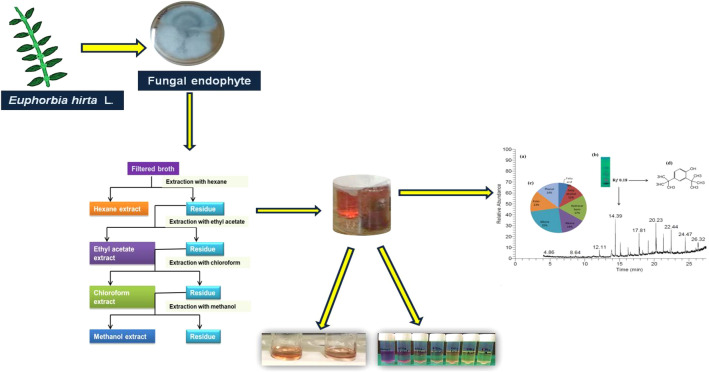- Record: found
- Abstract: found
- Article: not found
Phenolic and flavonoid contents and antioxidant activity of an endophytic fungus Nigrospora sphaerica (EHL2), inhabiting the medicinal plant Euphorbia hirta (dudhi) L.

Read this article at
Graphical abstract
Since endophytic fungi are pivotal sources of various bioactive natural compounds, the present study is aimed to investigate the antioxidant compounds of the endophytic fungus Nigrospora sphaerica isolated from a pantropical weed, Euphorbia hirta L. The fungus was fermented in four different media and each filtered broth was sequentially extracted in various solvents. Crude extracts collected from different solvents were subjected to phytochemical analysis and antioxidant activity. The total phenolic content (TPC) and total flavonoid content (TFC) were maximal in ethyl acetate crude extract (EtOAcE) of endophyte fermented in potato dextrose broth (PDB) medium (77.74 ± 0.046mgGAE/g and 230.59 ± 2.0 mgRE/g) with the highest 96.80% antioxidant activity. However, TPC and TFC were absent in hexane extract of Czapek Dox broth (CDB) medium exhibiting the lowest 4.63 ± 2.75% activity. The EtOAcE (PDB) showed a positive correlation between TFC and antiradical activity ( R 2 = 0.762; P < 0.05), whereas a high positive correlation was noticed between TPC and antioxidant activity ( R 2 = 0.989; P < 0.05). Furthermore, to determine the antioxidant activity, EtOAcE (PDB) was subjected to TLC bioautography-based partial purification, while GC/MS analysis of the partial purified extract was done to confirm the presence of phenolics along with antioxidant compounds that resulted in the detection of 2,4-Di-tert-butylphenol (13.83%), a phenolic compound accountable for the antioxidant potential. Conclusively, N. sphaerica is a potential candidate for natural antioxidant.

Related collections
Most cited references50
- Record: found
- Abstract: not found
- Article: not found
The determination of flavonoid contents in mulberry and their scavenging effects on superoxide radicals

- Record: found
- Abstract: found
- Article: found
Antioxidant and Oxidative Stress: A Mutual Interplay in Age-Related Diseases
- Record: found
- Abstract: found
- Article: not found
